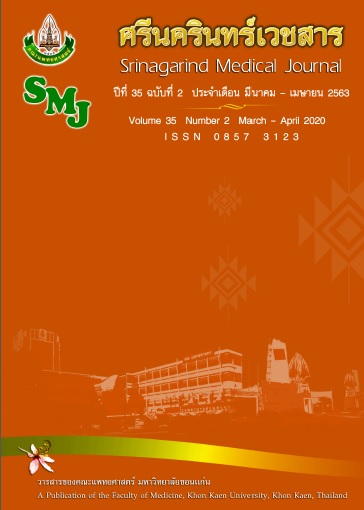Deceased Donor Kidney Transplantation in Pediatric Recipients: A Decade Results in Northeast Thailand
Keywords:
การปลูกถ่ายไต, ผู้ป่วยเด็ก, ผู้บริจาคสมองตาย, Kidney transplantation, Pediatrics, Deceased donorAbstract
การศึกษาย้อนหลังสิบปีในผู้ป่วยเด็กที่ได้รับการปลูกถ่ายไตจากผู้บริจาคสมองตายในภาคตะวันออกเฉียงเหนือ
สุนีย์ พนมบัวเลิศ*, สุวรรณี วิษณุโยธิน, อภิชาติ จิระวุฒิพงศ์
ภาควิชากุมารเวชศาสตร์ คณะแพทยศาสตร์ มหาวิทยาลัยขอนแก่น
หลักการและวัตถุประสงค์: การปลูกถ่ายไตเป็นการรักษาที่ดีที่สุดสำหรับผู้ป่วยเด็กโรคไตวายระยะสุดท้าย โรงพยาบาลศรีนครินทร์ได้ทำการปลูกถ่ายไตส่วนใหญ่จากผู้บริจาคสมองตายเนื่องจากระยะเวลารอไตไม่นาน ในอดีตมีการให้ยากดภูมิคุ้มกันชนิด interleukin 2 receptor antagonist (IL2-RA) ก่อนทำการผ่าตัดอย่างจำกัดเนื่องจากยามีราคาแพง การศึกษานี้จึงศึกษาผลของการปลูกถ่ายไตในเด็กจากผู้บริจาคสมองตายและไม่ได้รับยากดภูมิคุ้มกันชนิด IL2-RA
วิธีการศึกษา: การศึกษาผลการปลูกถ่ายไตแบบย้อนหลังสิบปีในผู้ป่วยเด็กที่ได้รับการปลูกถ่ายไตจากผู้บริจาคสมองตายตั้งแต่ปี พ.ศ. 2546 ถึง 2557 โดยผู้ป่วยทุกรายได้รับยากดภูมิคุ้มกันเหมือนกันทุกราย ยกเว้นยากดภูมิคุ้มกันชนิด IL2-RA ก่อนทำการผ่าตัดปลูกถ่ายไต และศึกษาผลของการปลูกถ่ายไตเทียบกลุ่มที่ได้รับยา IL2- RA และไม่ได้รับ
ผลการศึกษา: มีผู้ป่วยเด็กที่ได้รับการปลูกถ่ายไตทั้งหมดจำนวน 48 ราย อายุเฉลี่ยคือ 12.8 ปีและอายุเฉลี่ยของผู้บริจาคสมองตายคือ 30.3 ปี ผู้ป่วยเด็กที่ได้รับการปลูกถ่ายไตทุกรายได้รับการตรวจการเข้ากันได้ของเนื้อเยื่อกับผู้บริจาค จากจำนวนทั้งหมดมีผู้ป่วยเพียง 14 รายที่ได้รับยากดภูมิคุ้มกันชนิด IL2-RA ก่อนทำการผ่าตัดร่วมกับยาสเตียรอยด์ และกลุ่มที่ได้รับยาสเตียรอยด์อย่างเดียว พบว่าการเกิดภาวะปฏิเสธไตและการติดเชื้อของผู้ป่วยทั้งสองกลุ่ม ไม่แตกต่างกันอย่างมีนัยสำคัญทางสถิติ อัตราการรอดของไตที่ได้รับการปลูกถ่ายที่ 1, 3 และ 5 ปีหลังการปลูกถ่ายไต คือร้อยละ 93.7, 83.9, และ 74.8 ตามลำดับ นอกจากนี้พบว่าอัตราการรอดของไตระหว่างกลุ่มที่ได้รับยา IL2-RA และไม่ได้รับนั้น ไม่มีความแตกต่างกันอย่างมีนัยสำคัญทางสถิติเช่นกัน โดยมีอัตราการตายร้อยละ 16.7
สรุป: การปลูกถ่ายไตในเด็กจากผู้บริจาคสมองตายโดยไม่ได้รับยา IL2-RA ก่อนการผ่าตัดปลูกถ่ายไตนั้นได้ผลดี อย่างไรก็ตาม ยังต้องการการศึกษาในจำนวนผู้ป่วยที่มากขึ้นเพื่อยืนยันผลการศึกษาดังกล่าว
Background and objective: Kidney transplantation (KT) is the best modality treatment in children with end-stage renal disease. Our center has performed KT mostly from deceased donors due to short waiting time. The induction therapy by interleukin 2 receptor antagonist (IL2-RA) was limited use due to financial issue. Therefore, this study aimed to report our experience in pediatric deceased donor KT with restricted use of induction therapy.
Methods: This retrospective descriptive study, review the results of KT over 10 years. Medical records of all pediatric KT recipients who were transplanted from 2003 to 2014 were reviewed. All patients received the same maintenance immunosuppressive drugs except the induction therapy by IL2-RA. We also reviewed the results of KT between two groups in a different period.
Results: Forty-eight pediatric KT recipients were included in this study. The mean age of the recipients was 12.8 years and the mean age of the deceased donor was 30.3 years. All recipients were non-sensitized patients and compatible crossmatch. Fourteen patients (29%) received induction therapy with IL2-RA and methylprednisolone, the rest received only methylprednisolone (non-induction group). The rate of rejection and infection between the induction and non-induction groups did not differ significantly. The graft survival rates at 1, 3, and 5 years after KT were 93.7%, 83.9%, and 74.8%, respectively. The graft survival rates between induction and non-induction groups were not significantly different. The mortality rate of this study was 16.7%.
Conclusion: The standard-risk pediatric deceased donor kidney transplantation in limited resources for induction therapy had satisfying results. However, the future study requires a greater data to support this outcome.
References
Verghese PS. Pediatric kidney transplantation: a historical review. Pediatr Res 2017; 81: 259–64.
Harmon WE, McDonald RA, Reyes JD, Bridges ND, Sweet SC, Sommers CM, et al. Pediatric transplantation, 1994–2003. Am J Transplant 2005; 5: 887–903.
Van Arendonk KJ, Boyarsky BJ, Orandi BJ, James NT, Smith JM, Colombani PM, et al. National trends over 25 years in pediatric kidney transplant outcomes. Pediatrics 2014; 133: 594–601.
Rees L, Shroff R, Hutchinson C, Fernando ON, Trompeter RS. Long-term outcome of paediatric renal transplantation: follow-up of 300 children from 1973 to 2000. Nephron Clin Pract 2006; 105: c68–76.
Shapiro R. Living donor kidney transplantation in pediatric recipients. Pediatr Transplant 2006; 10: 844–50.
Mehrabi A, Kashfi A, Tonshoff B, Feneberg R, Mehls O, Schemmer P, et al. Long-term results of paediatric kidney transplantation at the University of Heidelberg: a 35 year single-centre experience. Nephrol Dial Transplant 2004; 19: iv69–74.
Pitcher GJ, Beale PG, Bowley DM, Hahn D, Thomson PD. Pediatric renal transplantation in a South African teaching hospital: a 20-year perspective. Pediatr Transplant 2006; 10: 441–8.
Groothoff JW, Cransberg K, Offringa M, van de Kar NJ, Lilien MR, Davin JC, et al. Long-term follow-up of renal transplantation in children: a Dutch cohort study: Transplantation 2004; 78: 453–60.
Sumboonnanonda A, Lumpaopong A, Kingwatanakul P, Tangnararatchakit K, Jiravuttipong A. Pediatric kidney transplantation in Thailand: experience in a developing country. Transplant Proc 2008; 40: 2271–3.
Rianthavorn P, Kerr SJ, Lumpaopong A, Jiravuttipong A, Pattaragarn A, Tangnararatchakit K, et al. Outcomes and predictive factors of pediatric kidney transplants: an analysis of the Thai Transplant Registry. Pediatr Transplant 2013; 17: 112–8.
Kidney Disease: Improving Global Outcomes (KDIGO) Transplant Work Group. KDIGO clinical practice guideline for the care of kidney transplant recipients. Am J Transplant 2009; 9: S1–155.
Gillen DL, Stehman Breen CO, Smith JM, McDonald RA, Warady BA, Brandt JR, et al. Survival advantage of pediatric recipients of a first kidney transplant among children awaiting kidney transplantation. Am J Transplant 2008; 8: 2600–6.
Sigurjonsdottir VK, Grimm PC. Living or deceased donor kidney transplantation in children. Curr Opin Pediatr 2019; 31: 232–6.
Hart A, Smith JM, Skeans MA, Gustafson SK, Wilk AR, Robinson A, et al. OPTN/SRTR 2016 annual data report: kidney. Am J Transplant 2018;18:18–113.
Butler T, Hayde N. Impact of induction therapy on delayed graft function following kidney transplantation in mated kidneys. Transplant Proc 2017; 49: 1739–42.
Hellemans R, Bosmans JL, Abramowicz D. Induction therapy for kidney transplant recipients: do we still need anti IL2 receptor monoclonal antibodies? Am J Transplant 2017; 17: 22–7.


